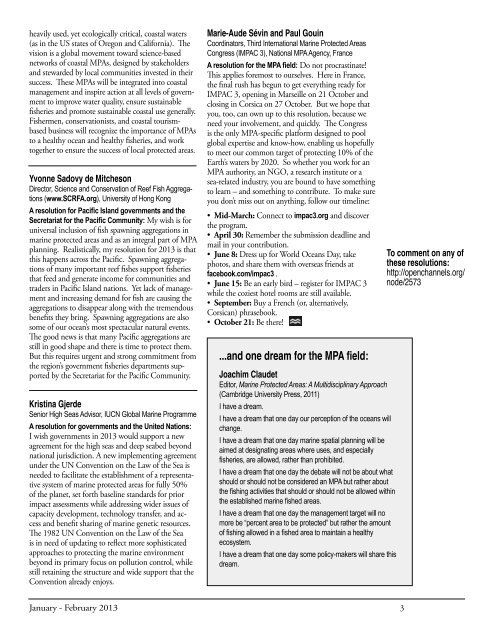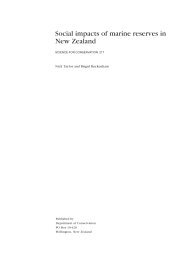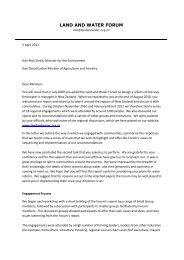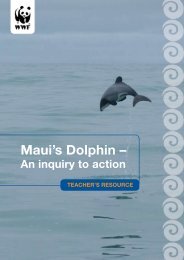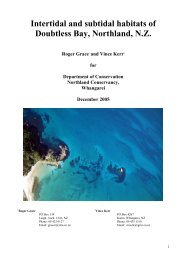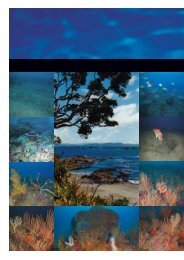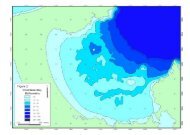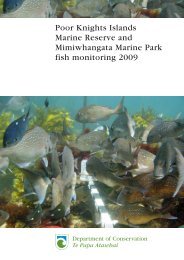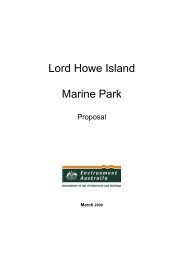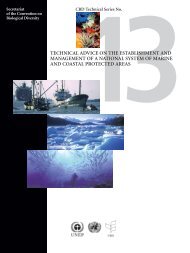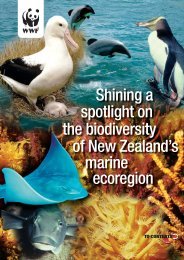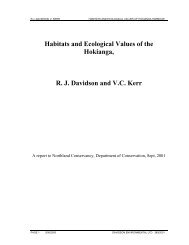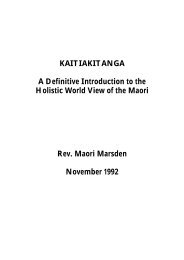MPA News - University of Washington
MPA News - University of Washington
MPA News - University of Washington
Create successful ePaper yourself
Turn your PDF publications into a flip-book with our unique Google optimized e-Paper software.
heavily used, yet ecologically critical, coastal waters(as in the US states <strong>of</strong> Oregon and California). Thevision is a global movement toward science-basednetworks <strong>of</strong> coastal <strong>MPA</strong>s, designed by stakeholdersand stewarded by local communities invested in theirsuccess. These <strong>MPA</strong>s will be integrated into coastalmanagement and inspire action at all levels <strong>of</strong> governmentto improve water quality, ensure sustainablefisheries and promote sustainable coastal use generally.Fishermen, conservationists, and coastal tourismbasedbusiness will recognize the importance <strong>of</strong> <strong>MPA</strong>sto a healthy ocean and healthy fisheries, and worktogether to ensure the success <strong>of</strong> local protected areas.Yvonne Sadovy de MitchesonDirector, Science and Conservation <strong>of</strong> Reef Fish Aggregations(www.SCRFA.org), <strong>University</strong> <strong>of</strong> Hong KongA resolution for Pacific Island governments and theSecretariat for the Pacific Community: My wish is foruniversal inclusion <strong>of</strong> fish spawning aggregations inmarine protected areas and as an integral part <strong>of</strong> <strong>MPA</strong>planning. Realistically, my resolution for 2013 is thatthis happens across the Pacific. Spawning aggregations<strong>of</strong> many important reef fishes support fisheriesthat feed and generate income for communities andtraders in Pacific Island nations. Yet lack <strong>of</strong> managementand increasing demand for fish are causing theaggregations to disappear along with the tremendousbenefits they bring. Spawning aggregations are alsosome <strong>of</strong> our ocean’s most spectacular natural events.The good news is that many Pacific aggregations arestill in good shape and there is time to protect them.But this requires urgent and strong commitment fromthe region’s government fisheries departments supportedby the Secretariat for the Pacific Community.Kristina GjerdeSenior High Seas Advisor, IUCN Global Marine ProgrammeA resolution for governments and the United Nations:I wish governments in 2013 would support a newagreement for the high seas and deep seabed beyondnational jurisdiction. A new implementing agreementunder the UN Convention on the Law <strong>of</strong> the Sea isneeded to facilitate the establishment <strong>of</strong> a representativesystem <strong>of</strong> marine protected areas for fully 50%<strong>of</strong> the planet, set forth baseline standards for priorimpact assessments while addressing wider issues <strong>of</strong>capacity development, technology transfer, and accessand benefit sharing <strong>of</strong> marine genetic resources.The 1982 UN Convention on the Law <strong>of</strong> the Seais in need <strong>of</strong> updating to reflect more sophisticatedapproaches to protecting the marine environmentbeyond its primary focus on pollution control, whilestill retaining the structure and wide support that theConvention already enjoys.Marie-Aude Sévin and Paul GouinCoordinators, Third International Marine Protected AreasCongress (I<strong>MPA</strong>C 3), National <strong>MPA</strong> Agency, FranceA resolution for the <strong>MPA</strong> field: Do not procrastinate!This applies foremost to ourselves. Here in France,the final rush has begun to get everything ready forI<strong>MPA</strong>C 3, opening in Marseille on 21 October andclosing in Corsica on 27 October. But we hope thatyou, too, can own up to this resolution, because weneed your involvement, and quickly. The Congressis the only <strong>MPA</strong>-specific platform designed to poolglobal expertise and know-how, enabling us hopefullyto meet our common target <strong>of</strong> protecting 10% <strong>of</strong> theEarth’s waters by 2020. So whether you work for an<strong>MPA</strong> authority, an NGO, a research institute or asea-related industry, you are bound to have somethingto learn – and something to contribute. To make sureyou don’t miss out on anything, follow our timeline:• Mid-March: Connect to impac3.org and discoverthe program.• April 30: Remember the submission deadline andmail in your contribution.• June 8: Dress up for World Oceans Day, takephotos, and share them with overseas friends atfacebook.com/impac3 .• June 15: Be an early bird – register for I<strong>MPA</strong>C 3while the coziest hotel rooms are still available.• September: Buy a French (or, alternatively,Corsican) phrasebook.• October 21: Be there!...and one dream for the <strong>MPA</strong> field:Joachim ClaudetEditor, Marine Protected Areas: A Multidisciplinary Approach(Cambridge <strong>University</strong> Press, 2011)I have a dream.I have a dream that one day our perception <strong>of</strong> the oceans willchange.I have a dream that one day marine spatial planning will beaimed at designating areas where uses, and especiallyfisheries, are allowed, rather than prohibited.I have a dream that one day the debate will not be about whatshould or should not be considered an <strong>MPA</strong> but rather aboutthe fishing activities that should or should not be allowed withinthe established marine fished areas.I have a dream that one day the management target will nomore be “percent area to be protected” but rather the amount<strong>of</strong> fishing allowed in a fished area to maintain a healthyecosystem.I have a dream that one day some policy-makers will share thisdream.To comment on any <strong>of</strong>these resolutions:http://openchannels.org/node/2573January - February 20133


